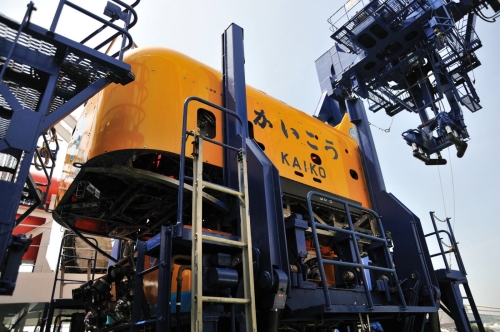“Kaiko” – a remotely operated underwater vehicle (ROV) built by the Japan Agency for Marine-Earth Science and Technology (JAMSTEC) for exploration of the deep sea. The research vessel (RV) “Kairei” serves as the support ship for “Kaiko” ROV.[1]
Designed for a full-depth ocean scientific research, “Kaiko” ROV consists of two separable parts: launcher and vehicle. The primary cable (∅ 45 millimeters x 12000 meters) links the RV “Kairei” and launcher, the secondary cable (∅ 29.5 millimeters x 250 meters) connects the launcher and vehicle (both optical/power composite cables). “Kaiko” is equipped by Lithium-ion electrical batteries. The tow speed is under 1.5 knot.[1][12][13]
Displacement of “Kaiko” ROV is 10.6 tons in air. The overall dimensions of launcher is 5.2 x 2.6 x 3.2 meters (Length x Width x Height). The vehicle has Manipulator and Sample basket. “Kaiko” is equipped by the various onboard facilities for navigation, observation and researches. Among them: Obstacle detecting sonar, Altimeter, Depth meter, Compass, TV cameras, Light, CTD etc.[1][12][13]
On 24 March 1995, during initial sea trials, “Kaiko” ROV became the first robot to reach the bottom of the Challenger Deep of Mariana Trench and the second vessel to visit this location (Don Walsh and Jacques Piccard became the first men to descend this place in the “Trieste” bathyscaphe on 23 January 1960). The maximum depth measured on dive of “Kaiko” was 10911.4 meters. At that time, the craft collected video and photographs of various barophilic benthos, including tubeworms and shrimp.[1][12][29]
In February 1996, “Kaiko” returned to Challenger Deep, this time collecting sediment and microorganisms from the seabed at a depth of 10898 meters.[1][12]
In December 1997, “Kaiko” located the wreck of “Tsushima Maru” ship on the sea floor off the coast of Okinawa.[1][12]
In May 1998, “Kaiko” returned again to Challenger Deep, this time collecting specimens of Hirondellea gigas.[1][12]
In October 1999, “Kaiko” performed a robotic mechanical operation at a depth of 2150 meters off the coast of Okinawa near the Ryukyu Trench, connecting measuring equipment with underwater cables on the sea floor.[1][12]
In late November 1999, “Kaiko” located the wreckage of “H-II” N 8, a NASDA rocket (sunken due to failure of launch), on the sea floor at a depth of 2900 meters off the Ogasawara Islands.[1][12]
In August 2000, “Kaiko” discovered hydrothermal vents and their associated deep sea communities at a depth of 2450 meters near the Central Indian Ridge.[1][12]
On 29 May 2003, at 296th dive, during Typhoon Chan-Hom, the vehicle of “Kaiko” ROV was lost at sea off the coast of Shikoku Island, when a secondary cable broke.[1][12][13]
In May 2004, JAMSTEC resumed its research operations, using another converted ROV as its vehicle: the ROV, formerly known as “UROV 7K”, was transformed to “Kaiko7000II” (this vessel can dive to a maximum depth of 7000 meters).[1][12][13]
“Kaiko” ROV did the deepest dive for an unmanned submersible, and it was the second of only four vessels ever to reach the bottom of the Challenger Deep (Don Walsh and Jacques Piccard in the “Trieste” bathyscaphe – 1960, “Kaiko” ROV – 1995, “Nereus” ROV – 2009, James Cameron in the submersible vessel “Deepsea Challenger” – 2012) to date. Between 1995 and 2003, this unmanned submersible gathered important data, numerous videos and photographs, samples, and conducted more than 250 dives, collecting 350 biological species (including 180 different bacteria), some of which could prove to be useful in medical and industrial applications.[1][11][29]
References:
1. Kaiko. – Mode of access: http://en.wikipedia.org/wiki/Kaik%C5%8D.
2. Japan Agency for Marine-Earth Science and Technology. – Mode of access: http://en.wikipedia.org/wiki/Japan_Agency_for_Marine-Earth_Science_and_Technology.
3. JAMSTEC – JAPAN AGENCY FOR MARINE-EARTH SCIENCE AND TECHNOLOGY. – Mode of access: http://www.jamstec.go.jp/e/.
4. 10,000m class deep sea ROV “KAIKO”. – Mode of access: http://www.jamstec.go.jp/jamstec-e/gallery/mujin/kaiko.html.
5. Kaiko < MOVIE. - Mode of access: http://www.jamstec.go.jp/jamstec-e/web_movie/kaiko_index.html.
6. Kaiko < MOVIE < Mariana trench (deepest in the ocean). - Mode of access: http://www.jamstec.go.jp/jamstec-e/web_movie/images/kaiko_1.mov.
7. Kaiko < MOVIE < Recovery scene. - Mode of access: http://www.jamstec.go.jp/jamstec-e/web_movie/images/kaiko_3.mov.
8. Kaiko < MOVIE < Launching. - Mode of access: http://www.jamstec.go.jp/jamstec-e/web_movie/images/kaiko_4.mov.
9. The Underwater Wonders Revealed by Kaiko. – Mode of access: http://www.tierramerica.net/english/2003/0721/iarticulo.shtml.
10. BBC NEWS | Science & Environment | Robot sub reaches deepest ocean. – Mode of access: http://news.bbc.co.uk/1/hi/sci/tech/8080324.stm.
11. Extremely Barophilic Bacteria Isolated from the Mariana Trench, Challenger Deep, at a Depth of 11,000 Meters. – Mode of access: http://aem.asm.org/content/64/4/1510.full.
12. KAIKO 7000II < Research Vessels and Vehicles < Research Vessels, Facilities and Equipment < About JAMSTEC < JAMSTEC. - Mode of access: http://www.jamstec.go.jp/e/about/equipment/ships/kaiko7000.html.
13. History of 7000m Class ROV KAIKO 7000. – Mode of access: http://www.jamstec.go.jp/jamstec-e/rov/pdf/kaiko_e.pdf.
14. File:JAMSTEC Deep Sea ROV kaikou7000.jpg. – Mode of access: http://en.wikipedia.org/wiki/File:JAMSTEC_Deep_Sea_ROV_kaikou7000.jpg.
15. File:AMSTEC Deep Sea ROV kaikou7000 Vehicle.jpg. – Mode of access: http://en.wikipedia.org/wiki/File:AMSTEC_Deep_Sea_ROV_kaikou7000_Vehicle.jpg.
16. File:JAMSTEC Deep Sea Research Ship Kairei.jpg. – Mode of access: http://en.wikipedia.org/wiki/File:JAMSTEC_Deep_Sea_Research_Ship_Kairei.jpg.
17. Submersible. – Mode of access: http://en.wikipedia.org/wiki/Submersible.
18. Подводный аппарат. – Mode of access: http://ru.wikipedia.org/wiki/%D0%9F%D0%BE%D0%B4%D0%B2%D0%BE%D0%B4%D0%BD%D1%8B%D0%B9_%D0%B0%D0%BF%D0%BF%D0%B0%D1%80%D0%B0%D1%82.
19. Remotely operated underwater vehicle. – Mode of access: http://en.wikipedia.org/wiki/Remotely_operated_underwater_vehicle.
20. Дистанційно-керований підводний апарат. – Mode of access: http://uk.wikipedia.org/wiki/%D0%94%D0%B8%D1%81%D1%82%D0%B0%D0%BD%D1%86%D1%96%D0%B9%D0%BD%D0%BE-%D0%BA%D0%B5%D1%80%D0%BE%D0%B2%D0%B0%D0%BD%D0%B8%D0%B9_%D0%BF%D1%96%D0%B4%D0%B2%D0%BE%D0%B4%D0%BD%D0%B8%D0%B9_%D0%B0%D0%BF%D0%B0%D1%80%D0%B0%D1%82.
21. Подводный телеуправляемый аппарат. – Mode of access: http://ru.wikipedia.org/wiki/%D0%9F%D0%BE%D0%B4%D0%B2%D0%BE%D0%B4%D0%BD%D1%8B%D0%B9_%D1%82%D0%B5%D0%BB%D0%B5%D1%83%D0%BF%D1%80%D0%B0%D0%B2%D0%BB%D1%8F%D0%B5%D0%BC%D1%8B%D0%B9_%D0%B0%D0%BF%D0%BF%D0%B0%D1%80%D0%B0%D1%82.
22. CTD (instrument). – Mode of access: http://en.wikipedia.org/wiki/CTD_%28instrument%29.
23. Research vessel. – Mode of access: http://en.wikipedia.org/wiki/Research_vessel.
24. Научно-исследовательское судно. – Mode of access: http://ru.wikipedia.org/wiki/%D0%9D%D0%B0%D1%83%D1%87%D0%BD%D0%BE-%D0%B8%D1%81%D1%81%D0%BB%D0%B5%D0%B4%D0%BE%D0%B2%D0%B0%D1%82%D0%B5%D0%BB%D1%8C%D1%81%D0%BA%D0%BE%D0%B5_%D1%81%D1%83%D0%B4%D0%BD%D0%BE.
25. Deep sea. – Mode of access: http://en.wikipedia.org/wiki/Deep_sea.
26. Mariana Trench. – Mode of access: http://en.wikipedia.org/wiki/Mariana_Trench.
27. Маріанський жолоб. – Mode of access: http://uk.wikipedia.org/wiki/%D0%9C%D0%B0%D1%80%D1%96%D0%B0%D0%BD%D1%81%D1%8C%D0%BA%D0%B0_%D0%B7%D0%B0%D0%BF%D0%B0%D0%B4%D0%B8%D0%BD%D0%B0.
28. Марианский жёлоб. – Mode of access: http://ru.wikipedia.org/wiki/%D0%9C%D0%B0%D1%80%D0%B8%D0%B0%D0%BD%D1%81%D0%BA%D0%B8%D0%B9_%D0%B6%D1%91%D0%BB%D0%BE%D0%B1.
29. Challenger Deep. – Mode of access: http://en.wikipedia.org/wiki/Challenger_Deep.
30. Безодня Челленджера. – Mode of access: http://uk.wikipedia.org/wiki/%D0%91%D0%B5%D0%B7%D0%BE%D0%B4%D0%BD%D1%8F_%D0%A7%D0%B5%D0%BB%D0%BB%D0%B5%D0%BD%D0%B4%D0%B6%D0%B5%D1%80%D0%B0.
31. Barry J. Revisiting the Challenger Deep using the ROV Kaiko / James P. Barry, Jun Hashimoto // Marine Technology Society Journal. – 2009. – v. 43. – N 5. – p. 1 – 2.
32. Christ R. The ROV Manual: A User Guide for Observation Class Remotely Operated Vehicles / Robert D. Christ, Robert L. Wernli Sr. – Oxford : Elsevier Ltd, 2007. – 310 p.
33. Underwater Vehicles / ed. Alexander V. Inzartsev. – Vienna : In-Tech, 2009. – 584 p.
1 Author released this work into the public domain.


